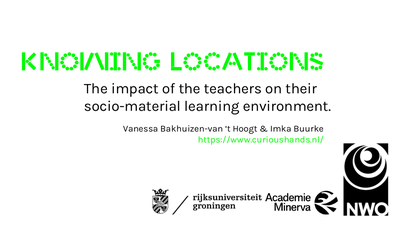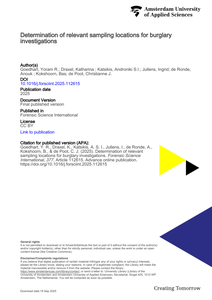Building on the metaphor of teachers as “knowing locations,” this contribution explores how teachers impact the socio-material learning environments. We illustrate how they influence teaching/learning making by zooming into two distinct settings: secondary school educational labs (E-labs) and art academy workshops. E-labs, with their clean, standardized, and technology-focused design, often hinder hands-on exploration due to restrictive material use and limited teacher involvement. Art academy workshops are richly personalized by technicians whose personal and pedagogical considerations deeply shape the learning atmosphere, either encouraging or deterring student engagement. By revealing the continuum of teachers’ influence on shaping socio-material relations within learning environments, we not only expose their role as ‘knowing locations”, but also emphasize the complex interplay between space, pedagogy, and embodied knowledge practices, in short, the ontological multiplicities of learning environments. We contribute to raising teacher’s critical spatial literacy.
MULTIFILE

Purpose This study aims to enhance understanding of the collaboration between chairs of nurse councils (CNCs) and members of executive hospital boards (BM) from a relational leadership perspective. Design/methodology/approach The authors used a qualitative and interpretive methodology. The authors study the daily interactions of BM and CNCs of seven Dutch hospitals through a relational leadership lens. The authors used a combination of observations, interviews and document analysis. The author’s qualitative analysis was used to grasp the process of collaborating between BM and CNCs. Findings Knowing each other, relating with and relating to are distinct but intertwined processes that influence the collaboration between BM and CNC. The absence of conflict is also regarded as a finding in this paper. Combined together, they show the importance of a relational process perspective to understand the complexity of collaboration in hospitals. Originality/value Collaboration between professional groups in hospitals is becoming more important due to increasing interdependence. This is a consequence of the complexity in organizing qualitative care. Nevertheless, research on the process of collaborating between nurse councils (NCs) and executive hospital boards is scarce. Furthermore, the understanding of the workings of boards, in general, is limited. The relational process perspective and the combination of observations, interviewing and document analysis proved valuable in this study and is underrepresented in leadership research. This process perspective is a valuable addition to skills- and competencies-focused leadership literature.
MULTIFILE

On a four-year bachelor course at Inholland University of Applied Sciences in the Netherlands, additional modern language was offered to first-year students studying at three locations. Since each location only had a few students and there was only one language teacher available, across the three locations, lessons were given by the teacher in a ‘hybrid’ classrooms. The teacher was at one location with some students while students from the other two locations would join via live video link. The focus was to develop speaking and listening skills through in-classroom discussion that took place via the video link. Short video news segments in the language were watched live in class. This lead to discussion and practicing the language. Learning support materials were available in the form of a grammar book with an online self-test learning environment. The research group conducted research on this original and creative solution to teaching smaller groups since much could be learned from a practical, didactic and organisational perspective. Several organisational issues influenced the course. And from a pedagogical perspective, this case supported findings from the literature that it is complicated to engage with students live in a classroom while also communicating with students at other locations via a video screen.
DOCUMENT

Residential burglaries often go unsolved, as collected DNA traces and fingermarks frequently originate from residents rather than the offender. It is therefore important to know how to target sampling locations that specifically relate to the burglary event. However, data that aid in assessing the likelihood of a burglar touching certain surfaces, and, consequently leaving trace evidence, is unavailable. Instead, forensic examiners rely primarily on their personal experience and expertise to determine where burglary-related traces are most likely to be found.The current study aims to identify specific areas that are contacted during different types of interactions with points of entry. An experiment was conducted at a Dutch music festival, where participants simulated both a legitimate and burglary scenario. Using paint, the points of contact between the participants’ hands and the experimental set-up were recorded. The contact locations of all participants were combined using heatmaps to reveal the patterns of contact. We found that different burglary methods lead to distinct contact patterns, indicating specific areas where traces are most likely to be deposited. Our findings can support forensic examiners in making evidence-based decisions during search strategies in burglary investigations.
MULTIFILE

How can Zuyd University promote knowledge sharing between different departments and locations, and what structures are needed to enable the knowledge sharing?
DOCUMENT

Knowing firefighters’ locations in a burning building would dramatically improve their safety. In this study from the Saxion Research Centre for Design and Technology in the Firebee project, an algorithm was developed and tested to enhance the estimation of a person’s location, based on inertial measurements combined with measurements of the earth’s magnetic field. The developed algorithm is an extension of the zero velocity update technique. Without any enhancements, the accuracy of the estimation is in the order of several meters after measuring for only a few seconds. With enhancements, the accuracy improved to be within five meters after measuring for ten minutes. Our result demonstrated that it is possible to determine in which room and on which floor a person is after ten minutes. Major improvements were observed in the estimation of the sensor’s height. The results are promising and the following phases of the project focus on improving the solution and on developing the concept into a practically applicable system.
MULTIFILE

This chapter discusses the following keywords for learning outcomes for Collaborative Online International Learning (COIL). 1. Clarity: Knowing what you want your students to achieve. 2. Shared: Designed together with your partner to match your course content. 3. Aligned: Linking different components (outcomes, assessment, and activities) of your COIL project together.
DOCUMENT

Ageing brings about physiological changes that affect people’s thermal sensitivity and thermoregulation. The majority of older Australians prefer to age in place and modifications to the home environment are often required to accommodate the occupants as they age and possibly become frail. However, modifications to aid thermal comfort are not always considered. Using a qualitative approach this study aims to understand the thermal qualities of the existing living environment of older South Australians, their strategies for keeping cool in hot weather and warm in cold weather and to identify existing problems related to planning and house design, and the use of heating and cooling. Data were gathered via seven focus group sessions with 49 older people living in three climate zones in South Australia. The sessions yielded four main themes, namely ‘personal factors’, ‘feeling’, ‘knowing’ and ‘doing’. These themes can be used as a basis to develop information and guidelines for older people in dealing with hot and cold weather. Original publication at MDPI: https://doi.org/10.3390/ijerph16060935 © 2018 by the authors. Licensee MDPI.
MULTIFILE

The focus of the thesis is an exploration into students’ vocational knowledge in the context of Dutch vocational education and training (VET). The reason students’ vocational knowledge requires exploration is because there is no consensus among scholars in the field of VET about how to theorise the nature of students’ vocational knowledge; most (not all) scholars rely on dichotomous conceptualisations, such as theory versus practice, general versus specific or explicit versus implicit. However, such commonly used dichotomies are not very helpful to understand the complex nature of vocational knowledge. Vocational knowledge is more than putting bits of theoretical and practical knowledge together, it is characterised by sometimes-intimate relationships between knowledge and actions. As a result of the above-mentioned gap in the VET literature, there is little empirical research on how VET students develop vocational knowledge and the extent to which this is occupation-specific knowledge. To understand students’ vocational knowledge, four different aims are formulated and carried out in four studies. The aim of the first study is to identify powerful vocational learning environments to enable the selection of a case that represents high quality vocational learning and teaching. With an eye on analysing students’ vocational knowledge, the second study aims to conceptualise the nature of vocational knowledge that avoids dichotomies. Therefore, two conceptual frameworks are integrated; the idea of contextualising is introduced which is based on cultural-historical theory to highlight the crucial role activity plays in knowledge development and to understand the relationships between the mind (i.e., what people think (and feel)), and action (i.e., what people do). Secondly, the theory is supplemented with ideas from inferentialism, a philosophical semantic theory of meaning to provide a useful way to focus on students’ processes of knowing and to reveal students’ vocational knowledge in terms of ongoing reasoning processes. The third study uses the conceptualisation of vocational knowledge to explore how students develop vocational knowledge in occupational practice, and to illustrate the process of contextualising. The forth study aims to describe what characterises students’ vocational knowledge using an analytic framework that distinguishes between occupation-specific knowledge components and qualities. This thesis contributes to research scholarship in the field of VET and an understanding of students’ vocational knowledge in practice. The theoretical framework of contextualising supplemented with inferentialism provides an alternative way to focus on students’ processes of knowing and helps to reveal students’ vocational knowledge in terms of reasoning processes. The empirical explorations and illustrations of students’ vocational knowledge contribute to the scholarly literature and practice on understanding the nature of vocational knowledge, how students develop vocational knowledge and what characterises their vocational knowledge. The intention to introduce the idea of contextualising is not about reinventing the wheel but rather an attempt to understand how it turns and how it functions. The intention of this thesis is to encourage dialogue and move the debate about the nature of vocational knowledge further, and hence, to provide some “food for thought”.
DOCUMENT
